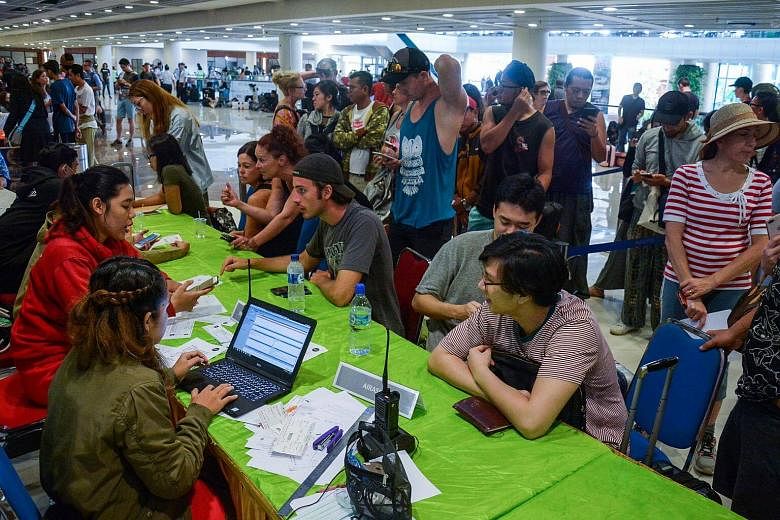JAKARTA - Mount Agung's ongoing eruption and escalating number of travel disruptions are likely to hit not just Bali but also Indonesia's tourism industry hard, officials say.
About 600,000 foreign tourists visit Bali each month. The Indonesian Hotel and Restaurant Association's Bali chapter estimates that the industry loses 13 million rupiah (S$1,294) each time a tourist makes a cancellation.
Some industry officials also do not expect Indonesia to hit this year's target of 15 million foreign tourist arrivals.
Hotels are already receiving large numbers of cancellations, said Mr Bagus Sudibya, chairman of the board of advisers at the Bali chapter of the Association of the Indonesian Tours & Travel Agencies.
"Huge cancellations. It is going to hurt businesses if it continues for long. Normally, the number of passengers coming to Bali is between 15,000 and 20,000 each day. (Those) leaving Bali is about the same number. If we convert the numbers to hotel rooms, we multiply that by two-thirds, because some are couples. If 15,000, then 10,000 hotel rooms," he said.
Mr Iman Ardiansyah, an executive at Ayodya Resort Bali, Nusa Dua, told The Straits Times that the hotel was giving discounts of up to 20 per cent to stranded guests.
In comments via Facebook messenger, he said the hotel has lost about 1 billion rupiah (S$99,450) from cancellation of rooms and events.
On Tuesday (Nov 28), 443 flights have been cancelled affecting up to 59,000 people, Mr Ari Ahsan, spokesman for Ngurah Rai airport, told The Straits Times. That figure is based on the seat capacity of the cancelled flights.
Stranded tourists in Bali are being given assistance to leave by land and sea or offered room discounts if they want to extend their stay, Mr Bagus said.
"For guests who need to leave urgently, they are being assisted to take the land route, crossing over to Java by ferry and then flying home from Surabaya airport (in East Java)," he told The Straits Times. The trip takes 10 to 12 hours.
"Tourists stranded at Bali airport were provided with free transportation to Mengwi bus terminal, where they can catch a bus to Surabaya," he said. The airport is about an hour away from Mengwi.
Another option, like what some hotels have done, is to offer guests a generous room discount for the first day of their extended stay "to express our empathy", said Mr Bagus.
Mr Bagus noted that most tourists fly into Bali rather than take the day-long land and ferry journey from Surabaya or the nearby island of Lombok.
"Now Lombok airport is open but traffic is very low. It could be because not many passengers want to fly, or the airlines are worried their planes may get grounded in Lombok... They may be able to land but not take off later."
Mr Bagus expects most travellers will give Bali a miss for now.
"They don't want uncertainty... (so instead they) go to Bangkok, Singapore, or KL."
Tourism officials are already toting up the likely cost of Mount Agung eruption to the country's tourism sector.
Mr Didien Djunaedy, chairman of the Association of the Indonesian Tourist Industry, told The Jakarta Post that the government would likely see a 20 to 30 per cent shortfall in its target of 15 million foreign tourist arrivals this year.
Last year, Indonesia received 11.5 million foreign tourists, nearly five million of whom went to Bali.
"We were at the finish line, and then unfavourable conditions arose," Mr Didien said, adding that he had initially expected up to three million inbound tourists in the last two months of this year.
Tourism Minister Arief Yahya said that, at best, Indonesia might achieve 95 per cent of its foreign tourist target by the end of this year.
"(This is) a hard time for tourism in Bali, Lombok and Indonesia," Mr Arief said."Bali is like our main (tourism) product. And then came this natural disaster."
Mount Agung rumbled back to life in September, forcing 140,000 people living nearby to be evacuated. Some of the islanders returned to their homes last month when the alert level was lowered.
According to official estimates, the major evacuation cost Bali at least US$110 million (S$148 million) in tourism and productivity losses.



